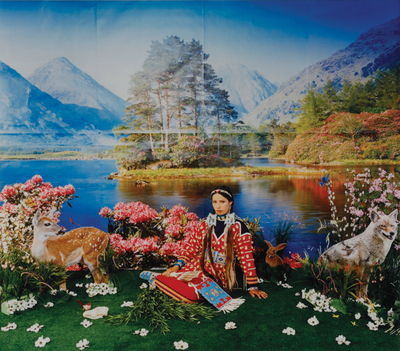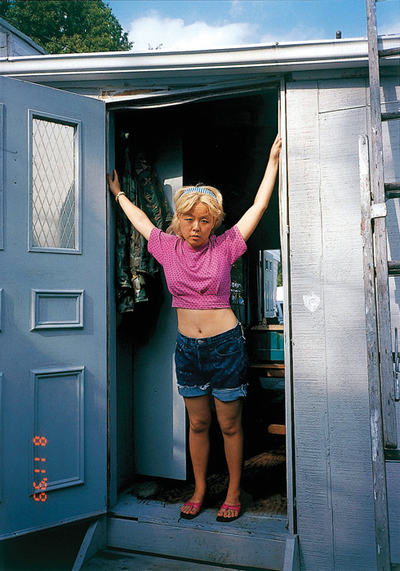About Face: Self-portraiture in Contemporary Art
Wendy Red Star, Spring from The Four Seasons series, negative 2006; print July 1, 2014, archival pigment print on Museo silver rag on dibond. Hood Museum of Art, Dartmouth College: Purchased through the Acquisition and Preservation of Native American Art Fund; 2014.50.3. © Wendy Red Star.
Despite today’s deluge of digital narcissism, self-portraiture remains as relevant in the “age of the selfie” as it was in the 1600s when Albrecht Dürer scratched his likeness into copper with a burin chisel.
The works in About Face, a sampling of recent modes of the self-portrait curated by Dartmouth students, all impose some form of aesthetic and/or cognitive distance between subject and depiction. By this indirect route, the art of the self-portrait becomes as much or more about the idea of self-representation as it is about questioning the nature of the self being represented.
A prime example is one of Chuck Close’s “pixilated” self-portraits (his gridding process actually predates computer pixilation). The colorful, loopy, amoeba-like ovals, teardrops, circles and squares in the 2012 silkscreen Self-Portrait blissfully subordinate subject (a massive close-up of Close’s now-famous face) to description. Painter Susanna Coffey also constructs a tessellated human visage through a mosaic-like painting process. Her Intake summons the artist’s facial features from a grid-like mesh of painterly lines and dots that, even while insisting on the two-dimensionality of paint, evokes a dense, three-dimensional, womblike space.
Black Gum #2 by Christian Thompson (featured on the cover of Art New England’s November/December 2012 issue), an Australian Aboriginal artist, removes the subject’s identity completely. Thompson’s photograph hints at indigenous and urban identity politics by presenting the stark image of a figure in a black hoodie with flowers for a face. As cued by the title, the plant turns out to be the lush leaves and flowers of a native Australian eucalyptus, or gum tree, and the work poses questions about the de-humanization of individuals by clichés of race and nationality. Yet the viewer need not catch all the political overtones; the image is ambiguous and disturbing enough simply as a strange conflation of archetypes both classic and contemporary.
Politics, particularly the freedom of expression and human rights in his native China, underlies Ai Weiwei’s Wanted Poster. An outspoken dissident and artistic provocateur, Weiwei appropriates Marcel Duchamp’s 1963 wanted poster, itself a reproduction of a 1923 work in which Duchamp appropriated a pre-printed joke card. As an appropriation of an appropriation of an appropriation, etc., Weiwei argues for the reinvigoration of art with urgent political content; Weiwei has altered the original, frivolous text to highlight the political situation in China, demanding an end to his “country arrest” (China has confiscated his passport and prohibited his travel outside its borders).
Nikki S. Lee, The Ohio Project, 1999, Fujiflex print. Hood Museum of Art, Dartmouth College. Purchased through the Elizabeth and David C. Lowenstein ’67 Fund; 2007.59. © Nikki S. Lee.
Enrico Riley’s Poet, a wax-pastel painting in primary colors, borrows from the bold, primitivistic self-portraits of Picasso and Basquiat. Calmer and more contemplative than either of his forbears, Riley in this work demonstrates a strong sense of mission supported by an intuitive, open-ended approach.
Photographer Nikki S. Lee disguises and immerses herself Zelig-like for months at a time in character identities associated with stereotypical American subcultures (e.g., “urban punk,” “yuppie”). In Ohio Project 8, she appears as a denizen of trailer park culture, leaning deadpan in blonde wig, pink midriff halter, cutoff jeans and plastic flip-flops at the mouth of a prefab trailer door. As she did for this chromogenic print (a copy of which also resides in the permanent collection of New York’s Metropolitan Museum), she eventually coaxes someone from her adopted community into photographing her with a cheap point-and-shoot camera before moving on to her next subversive charade.
At first the four images from Martín Gutierrez’s “Real Dolls” series seem based on a prop: the blow-up sex doll. Yet in each print, Gutierrez stars as the real object of domestic and sexual objectification and abuse. In Real Dolls (Ebony), he stars as Luxx, a sex doll evidently as stiff and posed as she is splayed open, on a sheet of bubble wrap, in an anonymous light-flooded bedroom that could be in a motel or a suburban ranch.
Similarly, works by Cindy Sherman, Kiki Smith and Bruce Nauman all perform some dramatic distortion of the self. Sherman stars as anonymous passengers in three examples of her early “Bus Riders” series, which presaged her career’s extended exploration of self, identity and representation. Smith’s My Blue Lake shockingly flattens the artist’s body into a pallid, two-dimensional pool, while Cockeye Lips, an infrared, yellow-filtered close-up of Nauman’s finger-twisted mouth, manages at once to be funny, disturbing, irreverent and banal.
If there is a unifying theme, it’s that in nearly all the self-portraits on view, as one of the student-penned labels aptly states, “it is the process of description that renders meaning rather than the subject itself.”


